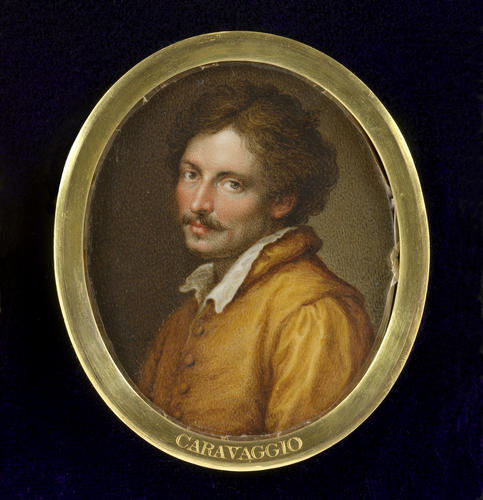Caravaggio (1571-1610) c.1772-80
Watercolour on ivory | 6.8 x 5.5 cm (sight) (sight) | RCIN 421215
-
Michelangelo Merisi (1571-1610) was born in Caravaggio, near Bergamo, and is considered to be one of the most important Italian painters of the seventeenth century. He was known for the realism in his paintings – which often shocked contemporaries – and for his use of chiaroscuro (dramatic light and shade). When he was about 12 years old he was apprenticed to a Milanese painter, but by 1592 he had settled in Rome. His early works consisted of realistic genre pictures of gypsies, card players and musicians, while he later produced powerful and arresting religious paintings. His first major patron was Cardinal Francesco del Monte, through whom he probably gained his first public commission – two canvasses of the Calling of Saint Matthew and the Martyrdom of Saint Matthew for the Contarelli chapel in S Luigi dei Francesi, painted around 1599-1600. Caravaggio had a difficult and sometimes violent personality; in 1606 he killed a man and had to flee Rome and spend the rest of his life in exile in Naples, Sicily and Malta. He died of malaria, aged 38, when he was on his way back to Rome, hoping for a pardon. There are two paintings by Caravaggio in the Royal Collection, The Calling of Saints Peter and Andrew (RCIN 402824) and Boy Peeling Fruit (RCIN 402612).
This miniature is one of the collection of copies of 224 self-portraits by artists in the Uffizi Palace, Florence, that Lord Cowper, the art collector and patron, commissioned from Giuseppe Macpherson (1726-80). He presented the miniatures to King George III in two batches, in 1773 and 1786. Macpherson followed the original self-portraits quite closely, but copied only the head and shoulders. He inscribed the artists' names on the backs of the miniatures – several differ from those in the modern Uffizi catalogue, notably: Bazzi, Bellini, Campi, Annibale Carracci, Gabbiani, Masaccio, Metsys, Moroni, Pencz, Licinio, Schiavone and Spada. None of the miniatures is signed, apart from Macpherson's own self-portrait, which is inscribed: Giuseppe Macpherson / Autore della serie (Giuseppe Macpherson / Author of the series). Macpherson was born in Florence, the son of Donald Macpherson, a footman in the service of Alexander, 2nd duke of Gordon. He was a pupil of Pompeo Batoni and painted miniatures and enamel portraits in Italy, France and Germany, finally settling in Florence. A James Macpherson is recorded in London and Paris in 1754 but it is not certain that this is the same person. He was described in 1776 as having a special talent for painting on enamel and as being 'almost the only painter in Europe who possesses this art to perfection'. He had a distinguished client list which included some of the crowned heads and dignitaries of Europe. In 1778, he was invited to add his own self-portrait to the famous painters in the grand duke's collection as it 'would do honour to Florence to enrich the collection with a work which shows that we still have some men of true merit', according to Giuseppe Pelli, director of the Uffizi.
Provenance
Presented to George III by Lord Cowper
-
Creator(s)
Acquirer(s)
-
Medium and techniques
Watercolour on ivory
Measurements
6.8 x 5.5 cm (sight) (sight)
Category
Object type(s)
Other number(s)
RL 02.9/32Alternative title(s)
Michelangelo Merisi da Caravaggio (1573-1610)









